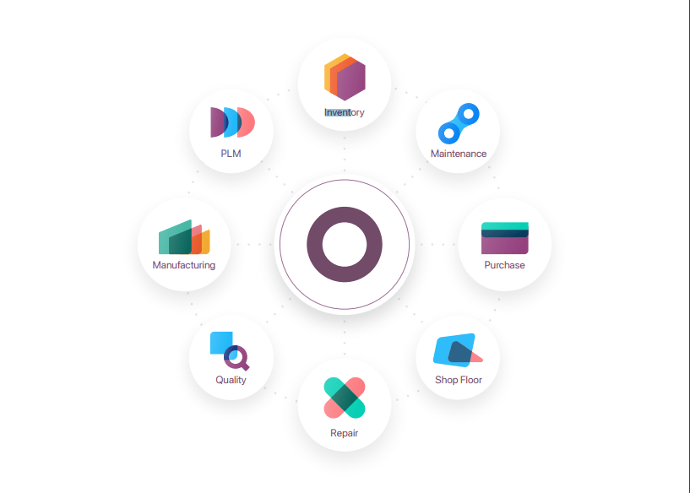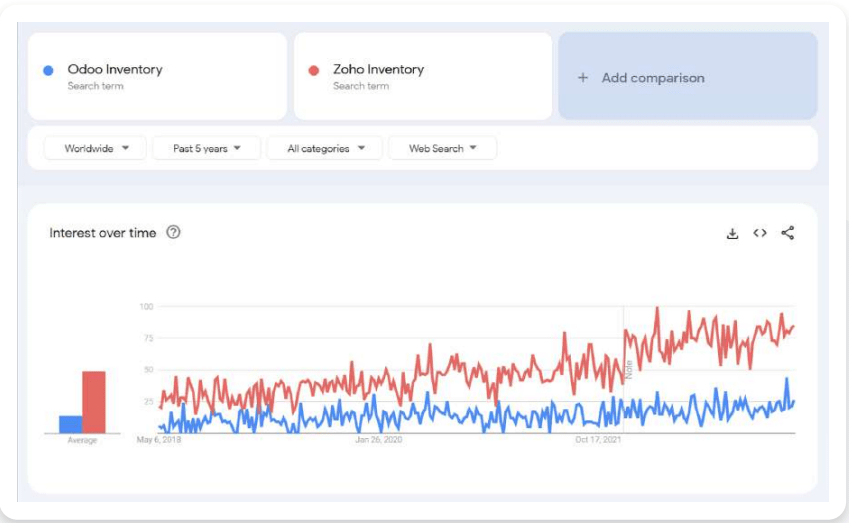Introduction
Competent inventory management is the backbone of any successful commerce-based business.
How many products do you sell? How many of each product do you have on-hand? How many will
you have next week, next month, or next year?
These aren’t simple questions, and they only become more complicated as your business grows.
However, knowing how to answer them can be a deciding factor in how fast that growth happens -
or if it happens at all.
Fortunately, for the modern business owner, there is no shortage of applications and platforms
designed to reduce the complexity of managing inventory. Keep reading for a comprehensive
overview of two of the most popular inventory management systems. Odoo and Zoho Inventory.
Features Comparison Overview
In this document, we will compare Odoo and Zoho Inventory, in order to analyze the key differences
and similarities between the two platforms. This is done with the purpose of helping readers better
understand each platform, arming them with the necessary knowledge to make an informed
decision about which one is right for their specific needs.
This comparison will consider a number of factors, including functionality, pricing, and usability. To
simplify the comparison, we’ve put much of the data into a series of tables that will allow readers to
easily determine the features of each platform.
Odoo
Odoo was founded in Belgium in 2005, and was originally known as TinyERP. Today, Odoo
provides a full suite of business management software tools that continues to grow. Odoo
currently has 19 offices located in 14 different countries. In 2022, Odoo switched to a simplified
pricing structure that provides access to every Odoo app for a single “per-user” fee.
“Because Amazing Employees
Deserve Amazing Software”
12+
million users
|
80+
apps
|
5k+partners
|
3.6k+
employees
|
Zoho Inventory
Originally founded in 1996, as AdventNet, Inc., the company was renamed to Zoho Corporation in
2009. Zoho is based in India, and has offices in nine countries around the world. They provide a
variety of business management products, including a CRM platform and an office suite. In 2015,
Zoho released Zoho Inventory, an inventory management system.
“Your life’s work, powered by
our life’s work”
80+
million users
|
40+
apps
|
700+
partners
|
17k+
employees
|
Why Odoo is being compared to Zoho Inventory
(not Zoho One)
Those familiar with Zoho’s offering already know that Zoho Inventory can be purchased as a
standalone product, or as part of the Zoho One subscription, which includes a variety of different
Zoho apps. For the purposes of this whitepaper, the standalone version of Zoho Inventory will be
compared with the full Odoo platform, with select references to the Zoho One offering, where
necessary. The reasons for this decision are outlined below.
While each company offers a free version of their software, the free version of Odoo provides full
access to the entire Inventory app. On the other hand, the free version of Zoho Inventory only
provides partial access to the Inventory app, with full functionality locked behind a tiered
subscription system.
Furthermore, Odoo allows subscribers to choose either the free version of one app, or pay a
subscription fee to access every app. Zoho Inventory can be paid for without gaining access to
other Zoho apps, which are available by subscribing to Zoho One, or by paying for each
additional app individually.
In summary, Odoo is a standalone product that costs a single fee to access the entire platform,
including Odoo Inventory. In the case of Zoho, however, Zoho Inventory is a standalone product.
Paying for it does not grant access to any additional applications. For these reasons, we believe
that it makes sense to use Zoho Inventory for this comparison. Some details about Zoho One will
also be provided, where necessary or relevant.
For the most part, this whitepaper provides an analysis of the paid version of Odoo and the paid
version of Zoho Inventory. If the free version of either app is being referenced, it will be explicitly
noted.
Open-Source
vs.
Closed-Source Software
Possibly the largest difference between Odoo and Zoho Inventory is the fact that the Odoo
platform is available in both open-source and licensed formats, while every Zoho app is
closed-source software. This is a difference that transcends the simple functionality of each
platform, speaking to the inherent design philosophy on which they are built.
To put it simply, saying that software is open-source means that users have access to its source
code. This provides total transparency to the user, allowing them to see the building blocks on
which the software is built.
It also means that users can make changes to the software as they see fit, empowering them to
reshape it into whatever they require. This can be something as simple as changing the color of a
banner, or as complicated as creating a whole new app within a platform.
Open-source software also allows you to take advantage of changes that other users have made.
This opens up a whole new world of possibilities, enabling collaboration with others to learn their
strategies and solutions, and show them what you’ve discovered and created.
In certain cases, open-source software can even be more secure than closed-source software.
This is because there are more people looking at the code due to it being freely available, which
means that vulnerabilities are more likely to be found. Allowing users to change the code
themselves also means that those vulnerabilities can be fixed faster.
There are, of course, advantages to using closed-source software, as well. For instance, the
developer of the software takes care of everything related to how it functions. Bug fixes and new
features are simply applied with each subsequent update. Additionally, while security is not
something that users have control over, it’s also not something that they have to worry about, as
this is left to the developer.
Zoho, and other closed-source platforms, do not provide the flexibility that open-source software
offers. This is fine for those who don’t want to make customizations to the software they’re
paying for, but it also limits them to its built-in features.
Odoo, on the other hand, provides the best of both worlds - an open-source Community version
that can be adapted to any need, as well as a licensed Enterprise version.
It is worth noting that Odoo Enterprise, while not quite as flexible as its Community counterpart,
still allows for deep customization through the Odoo Studio offering. This provides a level of
flexibility that is not found in most closed-source software.
App Ecosystem
When choosing an inventory management platform, another factor to consider is whether or not
the platform is part of a larger app ecosystem. This includes the variety of additional apps
available to users, as well as how those apps integrate and sync with each other.
In addition to Zoho Inventory, Zoho has a wide variety of other apps that comprise a full business
management suite. This includes apps dedicated to CRM, bookkeeping, marketing, HR, and more.
However, Zoho requires subscribers to pay an additional fee for each app, or purchase their
comprehensive Zoho One subscription.
With Odoo, paying for a subscription grants access to every available app, along with any
additional applications that get added in the future. This provides a full business management
platform that is able to grow alongside a company. For instance, you may start out using only
Odoo Inventory, but if you ever need a CRM app that integrates with it, you already have access
to Odoo CRM. Simply download it from the Apps application, and start using it right away.
If you do plan to use multiple apps, another factor to consider is how well they integrate with
each other. This includes making sure the data from one app mirrors what is found on every
other, as well as inter-app functionality, like having inventory products automatically linked to
sales orders that include them.
While Zoho users can sync data across multiple Zoho apps, this integration is less than seamless,
and requires input from the account owner to set up. For instance, to have Zoho CRM sync with
Zoho Inventory, the integration must be set up manually.
Odoo, on the other hand, is a completely holistic solution, with dozens of apps that work together
seamlessly without the need for manual integration or regular syncing. From the moment you
start using Odoo, the data in one app is always up-to-date with the rest of the platform, and will
always reflect what is displayed by another app.
If a standalone inventory app meets all of your requirements, then the ability to integrate it with
applications designed for other tasks may not be a critical selling point. However, if you’re looking
for a platform that can grow with your needs, then being part of a larger app ecosystem is
definitely a factor to consider.
General
|
Odoo
|
Zoho Inventory
|
Inventory Dashboard
|
✔
|
✔
|
Integrated Chat
|
✔
|
Only in $199 tier and higher
|
UoM Conversion
|
✔
|
Only in $199 tier and higher
|
Website Builder
|
✔
|
Only with Zoho One
|
Basic Multi-Currency
|
✔
|
Only in $79 tier and higher
|
Multi-Currency for Each
Contact
|
✔
|
Only in $299 tier and higher
|
eSignature
|
✔
|
✔
|
External API
|
✔
|
✔
|
Warehouse
|
Odoo
|
Zoho Inventory
|
Warehouses
|
Unlimited
|
2-151
|
Serial Number Tracking
|
✔
|
Only in $129 tier and higher
|
Batch/Lot Tracking
|
✔
|
Only in $129 tier and higher
|
Backorders
|
✔
|
✔
|
Picking Module
|
✔
|
✘
|
Picklist
|
✔
|
Only in $199 tier and higher
|
Trigger Operations Using
Barcodes
|
✔
|
✘
|
Forecasting
|
✔
|
✘
|
Lead Times
|
✔
|
✘
|
1 Depends upon Zoho Inventory pricing tier.
Sales
|
Odoo
|
Zoho Inventory
|
Sales Orders
|
Unlimited
|
50-25,000 per month1
|
CRM Integration
|
✔
|
✔
|
Customer Portal
|
✔
|
✔
|
Invoice for Partial Amounts
|
✔
|
✔
|
Returns
|
✔
|
✔
|
Dropshipping
|
✔
|
✔
|
Credit Notes
|
✔
|
✔
|
Shopify Integration
|
Requires Third-Party App
|
✔
|
Shipper Integration
|
✔
|
✔
|
AfterShip Tracking
|
Requires Third-Party App
|
✔
|
1 Depends upon Zoho Inventory pricing tier.
Purchase
|
Odoo
|
Zoho Inventory
|
Purchase Orders
|
Unlimited
|
20-15,000 per month1
|
Bills
|
Unlimited
|
20-15,000 per month1
|
Vendor Portal
|
✔
|
Only in $129 tier and higher
|
Automated Reordering
|
✔
|
✔
|
Purchase Approval
|
✔
|
✔
|
Vendor Payments
|
✔
|
✔
|
1 Depends upon Zoho Inventory pricing tier
Analytics
|
Odoo
|
Zoho Inventory
|
Records
|
Unlimited
|
5 million, and only in $399
tier and higher
|
Custom Reports
|
✔
|
Only in $399 tier and higher
|
Custom Dashboards
|
✔
|
Only in $399 tier and higher
|
Export Reports
|
✔
|
Only in $399 tier and higher
|
Financial Metrics
|
✔
|
Only in $399 tier and higher
|
Support
|
Odoo
|
Zoho Inventory
|
Email Support
|
24 hrs/day x 5 days/week
|
8 hrs/day x 5 days/week2
|
Toll-Free Support
|
24 hrs/day x 5 days/week
|
8 hrs/day x 5 days/week,
only for paid plans2
|
Product Documentation
|
✔
|
✔
|
Community Forums
|
✔
|
✔
|
2 For an additional fee of $49/month, $490/year, or 20% of the Zoho Inventory subscription fee, email and toll-free support
are available 24 hours/day for 5 days/week.
User
Interface
The features of a platform are important, but what’s almost as important is how you
experience those features. This is known as the user interface, and it includes the
appearance of an application, along with how you navigate through and interact with it,
among other things.
A good user interface should be intuitive, allowing for new users to acclimate to it quickly.
It should also be as concise as possible, while still providing the user with the right amount
of clarity regarding its various functions and abilities. In short, the best user interfaces are
the ones that appear virtually invisible to the user.
In the next few sections, this document will provide details about the user interfaces of the
Odoo Inventory and Zoho Inventory applications. This includes screenshots of important
features as they appear in each platform, as well as a table communicating their usability
attributes.
|
Odoo
|
Zoho Inventory
|
Main Dashboard
| 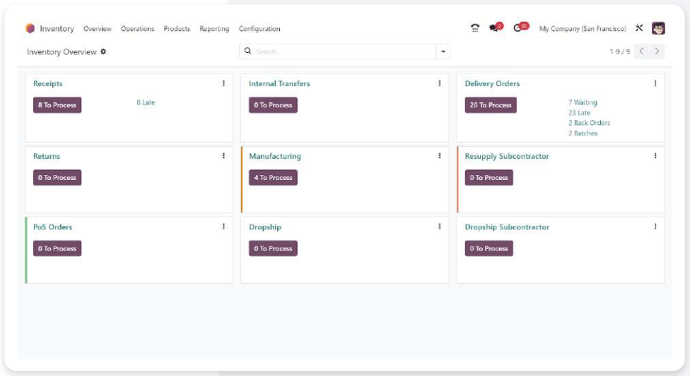
| 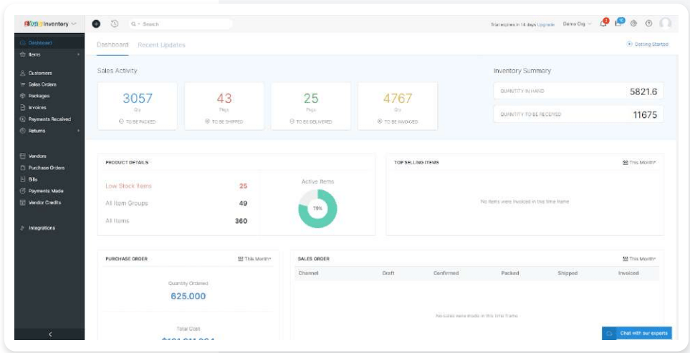
|
Products/Items
| 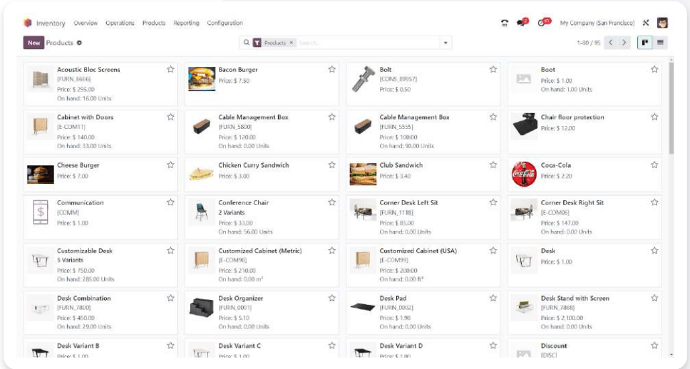
| 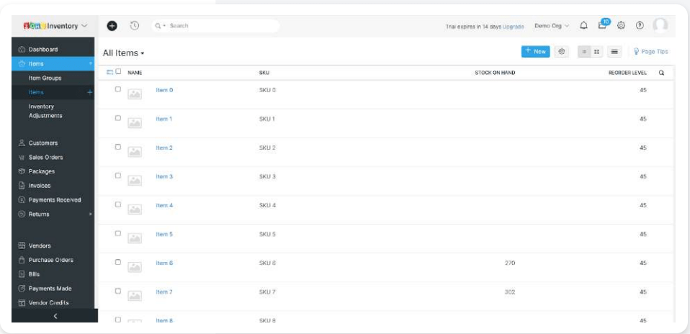
|
New Product
| 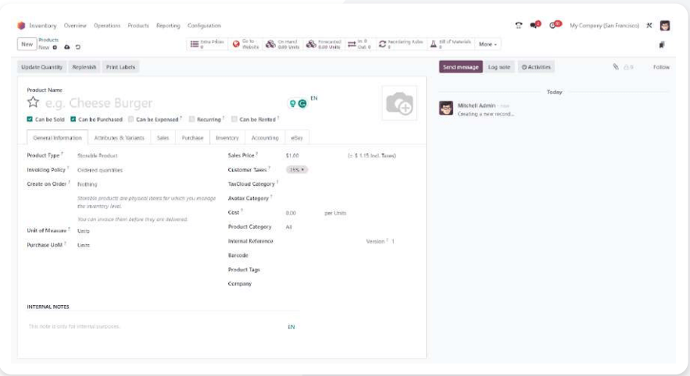
| 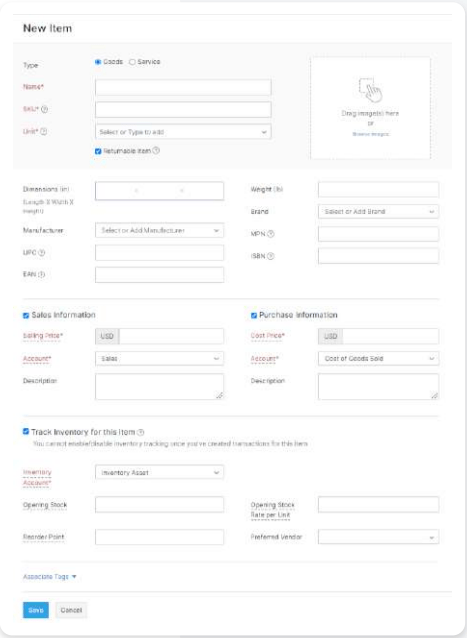
|
User Interface
|
Odoo
|
Zoho Inventory
|
Cloud-based Platform
| ✔
| ✔ |
Desktop App
| ✔ | ✘ |
On-Premise Deployment
| ✔ | ✘ |
Mobile App
| ✔ | ✔ |
Marketplace
| Odoo | Zoho Inventory |
Official Apps
| 80+
|
40+
|
User-Created Apps
| 16,000+
| 0 |
Configurability
| Odoo | Zoho Inventory |
Open-Source
| ✔
| ✘ |
Pricing
| Odoo | Zoho Inventory |
Free Version
| Yes, with full access to all Inventory app features1
|
Yes, with partial access to all
Inventory app features
|
Monthly Pricing
|
$31.10/user
|
$79 - $399/organization2
|
Users
| Unlimited
|
2-153
|
1 Odoo is free for unlimited users, as long as you only use the Inventory app. Access ALL Odoo apps for $31.10/month.
2 If Zoho Inventory is purchased as part of the Zoho One subscription, you can choose to pay $45/employee/month if a
license is purchased for EVERY employee. If you do not purchase a license for every employee, the subscription costs
$105/user/month.
3 Depends upon Zoho Inventory pricing tier.
User Satisfaction
| Odoo | Zoho Inventory |
User Reviews
|
|
|
Ratings on G2
|
|
|
Ratings on GetApp
|
|
|
Ratings on Capterra
|
|
|
Conclusion
Inventory management isn’t simple. Tracking on-hand product counts, forecasting future stock
levels, processing deliveries, accepting returns... these are just a few of the many vital elements
every company needs to manage efficiently. When it comes to the tasks required for managing
inventory properly, their number is matched only by their complexity.
As a result, the decision of which inventory management software is right for your business is not
one that should be taken lightly. The factors that must be considered are just as numerous as the
tasks the software needs to perform.
What is the best cost-to-feature ratio for your business? Will you only use the software to manage
inventory, or do you require solutions for manufacturing, project planning, marketing, etc.? If you do
need these additional solutions, how well must they integrate with the inventory management
software you choose?
These are some of the most important questions that need to be asked, but they are far from
everything that needs to be considered. No matter the size of your business, it’s important to weigh
the pros and cons of each solution carefully, only committing to one when you know that it meets
your needs better than any other. We hope the information in this document sets you on the path to
making the best decision for your specific needs.
Ready to supercharge your Businesses.
Jump-start your implementation and drive ROI by collaborating with industry experts, consultants, and
support engineers throughout your journey.
Our highly trained representative are standing by, ready to help
Installation & Configuration
Customization
|
|
